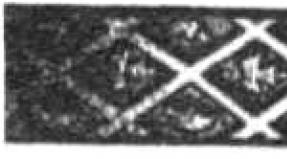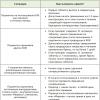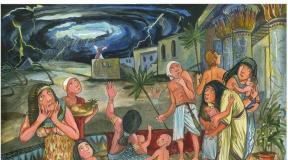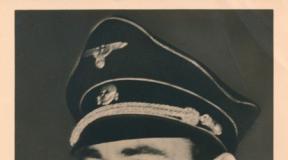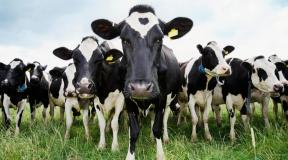What are chromosomes in biology. Chromosomes: structure, functions and anomalies. Genetic diseases associated with chromosomes
Chromosomes are self-reproducing structures of the cell nucleus. In both prokaryotic and eukaryotic organisms, genes are arranged in groups on individual DNA molecules, which, with the participation of proteins and other cell macromolecules, are organized into chromosomes. Mature cells of the germ line (gametes - eggs, sperm) of multicellular organisms contain one (haploid) set of chromosomes of the organism.
After complete sets of chromatids have moved to the poles, they are called chromosomes (chromosomes). Chromosomes are structures in the nucleus of eukaryotic cells that spatially and functionally organize DNA in the genome of individuals.
Each DNA molecule is packed into a separate chromosome, and all the genetic information stored in the chromosomes of one organism makes up its genome. It should be noted that chromosomes in a cell change their structure and activity in accordance with the stage of the cell cycle: in mitosis they are more condensed and transcriptionally inactivated; in interphase, on the contrary, they are active in relation to RNA synthesis and are less condensed.
To form a functional chromosome, a DNA molecule must be able not only to direct the synthesis of RNA, but also, by multiplying, be transmitted from one generation of cells to the next. This requires three types of specialized nucleotide sequences (these have been identified on the chromosomes of the yeast Saccharomyces cerevisiae).
1. For normal replication, a DNA molecule needs a specific sequence that acts as a replication origin (DNA replication origin).
2. The second necessary element - the centromere - holds two copies of the duplicated chromosome together and attaches any DNA molecule containing this sequence through a protein complex - the kinetochore to the mitotic spindle (during cell division so that each daughter cell receives one copy.
3. The third essential element that every linear chromosome needs is the telomere. The telomere is a special sequence at the end of each chromosome. This simple repeating sequence is periodically extended by a special enzyme, telomerase, and thus the loss of several nucleotides of telomere DNA that occurs in each replication cycle is compensated. As a result, the linear chromosome is completely replicated. All of the elements described above are relatively short (typically less than 1,000 base pairs each). Apparently, similar three types of sequences should also work in human chromosomes, but so far only telomeric sequences of human chromosomes have been well characterized.
In diploid (polyploid) organisms, the cells of which contain one (several) set of chromosomes from each of the parents, identical chromosomes are called homologous chromosomes, or homologues. The identical chromosomes of different organisms of the same biological species are also homologous.
Genes and non-coding nucleotide sequences, enclosed in the chromosomes of cell nuclei, represent a large part of the genome of an organism.
In addition, the genome of an organism is also formed by extrachromosomal genetic elements, which during the mitotic cycle are reproduced independently of the chromosomes of the nuclei. Thus, the mitochondria of fungi and mammals contain about 1% of the total DNA, while the budding yeast Sacharomyces cerevisiae contains up to 20% of the DNA of the cell. The DNA of plant plastids (chloroplasts and mitochondria) makes up from 1 to 10% of the total amount of DNA.
The genes that make up individual chromosomes are located in one DNA molecule and form a linkage group; in the absence of recombination, they are transferred together from parent cells to daughter cells.
The physiological significance of the distribution of genes over individual chromosomes and the nature of the factors that determine the number of chromosomes in the eukaryotic genome remain not fully understood. For example, it is impossible to explain the evolutionary mechanisms of the appearance of a large number of chromosomes in specific organisms only by restrictions imposed on the maximum size of DNA molecules that make up these chromosomes. Thus, the genome of the American amphibian Amphiuma contains ~30 times more DNA than the human genome, and all DNA is contained in only 28 chromosomes, which is quite comparable with the human karyotype (46 chromosomes). However, even the smallest of these chromosomes is larger than the largest human chromosomes. The factors that limit the upper limit of the number of chromosomes in eukaryotes remain unknown. For example, in the butterfly Lysandra nivescens, the diploid set is 380-382 chromosomes, and there is no reason to believe that this value is the maximum possible.
Normally, the number of chromosomes in a person is 46. Examples: 46, XX, a healthy woman; 46, XY, healthy male.
Chromosomes are the most important element of the cell. They are responsible for the transmission and implementation of hereditary information and in the eukaryotic cell are localized in the nucleus.
According to the chemical structure, chromosomes are complexes of deoxyribonucleic acids (DNA) and associated proteins, as well as a small number of other substances and ions. Thus, chromosomes are deoxyribonucleoproteins (DNP).
Each chromosome in interphase contains one long double-stranded DNA molecule. A gene is a sequence of a certain number of consecutive nucleotides that make up DNA. The genes that make up the DNA of one chromosome follow each other. In the interphase, many processes take place in the cell, many parts of the chromosome are despiralized to varying degrees. Many regions of DNA are involved in RNA synthesis.
During cell division (both during mitosis and meiosis), the chromosomes spiralize (their compaction occurs). At the same time, their length is reduced, and RNA synthesis on them becomes impossible. Prior to spiralization, each chromosome doubles. The chromosome is said to be made up of two chromatids. That is, during interphase, the chromosome consisted of one chromatid.
Proteins that make up the chromosome play an important role in the compaction of chromatids.
Thus, depending on the phase of the cell cycle, according to the external structure of the chromosome, they can be represented 1) as invisible in a light microscope chromatin(in interphase) and consist of one chromatid or 2) in the form of two spiralized chromatids visible in a light microscope (in the phases of cell division, starting from metaphase).
There is another important element in the structure of chromosomes - centromere(primary stretch). It is of a protein nature and is responsible for the movement of the chromosome, and the fission spindle threads are also attached to it. Depending on the location of the centromere, equal-arm (metacentric), unequal-arm (submetacentric) and rod-shaped (acrocentric) chromosomes are distinguished. In the first, the centromere is located in the middle, dividing each chromatid into two equal arms, in the second, the arms are of unequal length, and in the third, the centromere is located at one of the ends of the chromatid.
In doubled chromosomes, the chromatids are interconnected at the centromere.
Structure of a doubled chromosome.
1 - chromatid; 2 - centromere; 3 - short shoulder; 4 - long shoulder.
The presence of a primary constriction in the structure of chromosomes is mandatory. However, in addition to them, there are secondary constrictions ( nucleolar organizers), they are not observed in all chromosomes. In the nucleus, on the secondary constrictions of chromosomes, the synthesis of nucleoli occurs.
At the ends of the chromatids are the so-called telomeres. They prevent chromosomes from sticking together.
In a haploid set, each chromosome is unique in its structure. The position of the centromere (and the lengths of the chromosome arms resulting from this) makes it possible to distinguish each from the rest.
In the diploid set, each chromosome has a homologous one, having the same structure and the same set of genes (but possibly their other alleles) and inherited from another parent.
Each type of living organism is characterized by its own karyotype, i.e. its own number of chromosomes and their features (length, position of centromeres, chemical structure features). Biological species can be determined by karyotype.
Chromosomes are cell structures that store and transmit hereditary information. A chromosome is made up of DNA and protein. The complex of proteins associated with DNA forms chromatin. Proteins play an important role in the packaging of DNA molecules in the nucleus.
DNA in chromosomes is packed in such a way that it fits in the nucleus, which usually does not exceed 5 microns (5-10-4 cm) in diameter. The packaging of DNA takes the form of a looped structure, similar to amphibian lampbrush chromosomes or insect polytene chromosomes. The loops are maintained by proteins that recognize specific nucleotide sequences and bring them closer together. The structure of the chromosome is best seen in the metaphase of mitosis.
The chromosome is a rod-shaped structure and consists of two sister chromatids, which are held by the centromere in the region of the primary constriction. Each chromatid a is built from chromatin loops. Chromatin does not replicate. Only DNA is replicated.
When DNA replication starts, RNA synthesis stops. Chromosomes can be in two states: condensed (inactive) and decondensed (active).
The diploid set of chromosomes in an organism is called a karyotype. Modern research methods make it possible to determine each chromosome in the karyotype. For this, the distribution of light and dark bands visible under a microscope (alternation of AT and GC pairs) in chromosomes treated with special dyes is taken into account. Transverse striation is possessed by chromosomes of representatives of different species. In related species, for example, in humans and chimpanzees, the pattern of alternation of bands in the chromosomes is very similar.
First, let's agree on terminology. Human chromosomes were finally counted a little more than half a century ago - in 1956. Since then we have known that somatic, that is, not germ cells, there are usually 46 of them - 23 pairs.
Chromosomes in a pair (one received from the father, the other from the mother) are called homologous. They contain genes that perform the same functions, but often differ in structure. The exception is the sex chromosomes - X and Y, the gene composition of which does not completely match. All other chromosomes except the sex chromosomes are called autosomes.
Number of sets of homologous chromosomes - ploidy- in germ cells it is equal to one, and in somatic cells, as a rule, two.
So far, B chromosomes have not been found in humans. But sometimes an additional set of chromosomes appears in cells - then they talk about polyploidy, and if their number is not a multiple of 23 - about aneuploidy. Polyploidy occurs in certain types of cells and contributes to their increased work, while aneuploidy usually indicates violations in the work of the cell and often leads to its death.
Share honestly
Most often, the wrong number of chromosomes is the result of unsuccessful cell division. In somatic cells, after DNA duplication, the maternal chromosome and its copy are linked together by cohesin proteins. Then protein complexes of kinetochore sit on their central parts, to which microtubules are later attached. When dividing along microtubules, kinetochores disperse to different poles of the cell and pull chromosomes along with them. If the cross-links between copies of the chromosome are destroyed ahead of time, then microtubules from the same pole can attach to them, and then one of the daughter cells will receive an extra chromosome, and the second will remain deprived.

Meiosis also often passes with errors. The problem is that the construction of linked two pairs of homologous chromosomes can twist in space or separate in the wrong places. The result will again be an uneven distribution of chromosomes. Sometimes the sex cell manages to track this so as not to transmit the defect by inheritance. Extra chromosomes are often misfolded or broken, which triggers the death program. For example, among spermatozoa there is such a selection for quality. But the eggs were less fortunate. All of them are formed in humans even before birth, prepare for division, and then freeze. Chromosomes are already doubled, tetrads are formed, and division is delayed. In this form, they live until the reproductive period. Then the eggs mature in turn, divide for the first time and freeze again. The second division occurs immediately after fertilization. And at this stage, it is already difficult to control the quality of the division. And the risks are greater, because the four chromosomes in the egg remain cross-linked for decades. During this time, breakdowns accumulate in cohesins, and chromosomes can spontaneously separate. Therefore, the older the woman, the greater the likelihood of incorrect chromosome divergence in the egg.
Aneuploidy in germ cells inevitably leads to aneuploidy of the embryo. When a healthy egg with 23 chromosomes is fertilized by a sperm with an extra or missing chromosome (or vice versa), the number of chromosomes in the zygote will obviously be different from 46. But even if the germ cells are healthy, this does not guarantee healthy development. In the first days after fertilization, the cells of the embryo actively divide in order to quickly gain cell mass. Apparently, in the course of rapid divisions, there is no time to check the correctness of chromosome segregation, so aneuploid cells can arise. And if an error occurs, then the further fate of the embryo depends on the division in which it happened. If the balance is disturbed already in the first division of the zygote, then the whole organism will grow aneuploid. If the problem arose later, then the outcome is determined by the ratio of healthy and abnormal cells.
Some of the latter may die further, and we will never know about their existence. Or he can take part in the development of the body, and then he will succeed mosaic- different cells will carry different genetic material. Mosaicism causes a lot of trouble for prenatal diagnosticians. For example, at the risk of having a child with Down syndrome, sometimes one or more embryonic cells are removed (at the stage when this should not be dangerous) and the chromosomes are counted in them. But if the embryo is mosaic, then this method becomes not particularly effective.
Third wheel
All cases of aneuploidy are logically divided into two groups: deficiency and excess of chromosomes. The problems that arise with a deficiency are quite expected: minus one chromosome means minus hundreds of genes.

If the homologous chromosome is working normally, then the cell can get away with only an insufficient amount of proteins encoded there. But if some of the genes remaining on the homologous chromosome do not work, then the corresponding proteins will not appear in the cell at all.
In the case of an excess of chromosomes, everything is not so obvious. There are more genes, but here - alas - more does not mean better.
First, extra genetic material increases the load on the nucleus: an additional strand of DNA must be placed in the nucleus and served by information reading systems.
Scientists have found that in people with Down syndrome, whose cells carry an extra 21st chromosome, the work of genes located on other chromosomes is mainly disrupted. Apparently, an excess of DNA in the nucleus leads to the fact that there are not enough proteins that support the work of chromosomes for everyone.
Secondly, the balance in the amount of cellular proteins is disturbed. For example, if activator proteins and inhibitor proteins are responsible for some process in the cell, and their ratio usually depends on external signals, then an additional dose of one or the other will cause the cell to stop responding adequately to the external signal. Finally, an aneuploid cell has an increased chance of dying. When duplicating DNA before division, errors inevitably occur, and the cellular proteins of the repair system recognize them, repair them, and start doubling again. If there are too many chromosomes, then there are not enough proteins, errors accumulate and apoptosis is triggered - programmed cell death. But even if the cell does not die and divides, then the result of such division is also likely to be aneuploids.
You will live
If even within a single cell, aneuploidy is fraught with disruption and death, then it is not surprising that it is not easy for an entire aneuploid organism to survive. At the moment, only three autosomes are known - 13, 18 and 21, trisomy for which (that is, an extra, third chromosome in cells) is somehow compatible with life. This is probably due to the fact that they are the smallest and carry the fewest genes. At the same time, children with trisomy on the 13th (Patau syndrome) and 18th (Edwards syndrome) chromosomes live at best up to 10 years, and more often live less than a year. And only trisomy on the smallest in the genome, the 21st chromosome, known as Down syndrome, allows you to live up to 60 years.
It is very rare to meet people with general polyploidy. Normally, polyploid cells (carrying not two, but four to 128 sets of chromosomes) can be found in the human body, for example, in the liver or red bone marrow. These are usually large cells with enhanced protein synthesis, which do not require active division.
An additional set of chromosomes complicates the task of their distribution among daughter cells, so polyploid embryos, as a rule, do not survive. Nevertheless, about 10 cases have been described when children with 92 chromosomes (tetraploids) were born and lived from several hours to several years. However, as in the case of other chromosomal anomalies, they lagged behind in development, including mental development. However, for many people with genetic abnormalities, mosaicism comes to the rescue. If the anomaly has developed already during the fragmentation of the embryo, then a certain number of cells may remain healthy. In such cases, the severity of symptoms decreases and life expectancy increases.
Gender injustices
However, there are also such chromosomes, the increase in the number of which is compatible with human life or even goes unnoticed. And this, surprisingly, the sex chromosomes. The reason for this is gender injustice: about half of the people in our population (girls) have twice as many X chromosomes as others (boys). At the same time, the X chromosomes serve not only to determine sex, but also carry more than 800 genes (that is, twice as many as the extra 21st chromosome, which causes a lot of trouble for the body). But girls come to the aid of a natural mechanism to eliminate inequality: one of the X chromosomes is inactivated, twisted and turns into a Barr body. In most cases, the selection occurs randomly, and in some cells the maternal X chromosome is active, while in others the paternal X chromosome is active. Thus, all girls are mosaic, because different copies of genes work in different cells. Tortoiseshell cats are a classic example of such mosaicity: on their X chromosome there is a gene responsible for melanin (a pigment that determines, among other things, coat color). Different copies work in different cells, so the color is spotty and is not inherited, since inactivation occurs randomly.

As a result of inactivation, only one X chromosome always works in human cells. This mechanism allows you to avoid serious trouble with X-trisomy (XXX girls) and Shereshevsky-Turner syndromes (XO girls) or Klinefelter (XXY boys). About one in 400 children is born this way, but vital functions in these cases are usually not significantly impaired, and even infertility does not always occur. It is more difficult for those who have more than three chromosomes. This usually means that the chromosomes did not separate twice during the formation of germ cells. Cases of tetrasomy (XXXXX, XXYY, XXXY, XYYY) and pentasomy (XXXXX, XXXXY, XXXYY, XXYYY, XYYYY) are rare, some of which have been described only a few times in the history of medicine. All of these variants are compatible with life, and people often live to advanced years, with abnormalities manifesting themselves in abnormal skeletal development, genital defects, and mental decline. Tellingly, the extra Y-chromosome itself has little effect on the functioning of the body. Many men with the XYY genotype do not even know about their features. This is due to the fact that the Y chromosome is much smaller than the X and carries almost no genes that affect viability.
The sex chromosomes have another interesting feature. Many mutations in genes located on autosomes lead to abnormalities in the functioning of many tissues and organs. At the same time, most gene mutations on the sex chromosomes manifest themselves only in mental impairment. It turns out that, to a significant extent, the sex chromosomes control the development of the brain. Based on this, some scientists hypothesize that it is they who are responsible for the differences (however, not fully confirmed) between the mental abilities of men and women.
Who benefits from being wrong
Despite the fact that medicine has been familiar with chromosomal abnormalities for a long time, recently aneuploidy continues to attract the attention of scientists. It turned out that more than 80% of tumor cells contain an unusual number of chromosomes. On the one hand, the reason for this may be the fact that proteins that control the quality of division are able to slow it down. In tumor cells, these very control proteins often mutate, so division restrictions are removed and chromosome checking does not work. On the other hand, scientists believe that this may serve as a factor in the selection of tumors for survival. According to this model, tumor cells first become polyploid, and then, as a result of division errors, they lose different chromosomes or their parts. It turns out a whole population of cells with a wide variety of chromosomal abnormalities. Most of them are not viable, but some may accidentally succeed, for example, if they accidentally get extra copies of genes that start division, or lose genes that suppress it. However, if the accumulation of errors during division is additionally stimulated, then the cells will not survive. Taxol, a common cancer drug, is based on this principle: it causes systemic nondisjunction of chromosomes in tumor cells, which should trigger their programmed death.
It turns out that each of us can be a carrier of extra chromosomes, at least in individual cells. However, modern science continues to develop strategies to deal with these unwanted passengers. One of them proposes to use the proteins responsible for the X chromosome and incite, for example, the extra 21st chromosome of people with Down syndrome. It is reported that in cell cultures this mechanism was able to be brought into action. So, perhaps in the foreseeable future, dangerous extra chromosomes will be tamed and rendered harmless.
Polina Loseva
eukaryotic chromosomes
Centromere
Primary constriction
X. p., in which the centromere is localized and which divides the chromosome into shoulders.
Secondary constrictions
A morphological feature that allows you to identify individual chromosomes in a set. They differ from the primary constriction in the absence of a noticeable angle between the segments of the chromosome. Secondary constrictions are short and long and are localized at different points along the length of the chromosome. In humans, these are 13, 14, 15, 21 and 22 chromosomes.
Types of chromosome structure
There are four types of chromosome structure:
- telocentric(rod-shaped chromosomes with a centromere located at the proximal end);
- acrocentric(rod-shaped chromosomes with a very short, almost imperceptible second arm);
- submetacentric(with shoulders of unequal length, resembling the letter L in shape);
- metacentric(V-shaped chromosomes with arms of equal length).
The chromosome type is constant for each homologous chromosome and may be constant in all members of the same species or genus.
Satellites (satellites)
Satellite- this is a rounded or elongated body, separated from the main part of the chromosome by a thin chromatin thread, equal in diameter or somewhat smaller than the chromosome. Chromosomes that have a companion are commonly referred to as SAT chromosomes. The shape, size of the satellite and the thread connecting it are constant for each chromosome.
nucleolus zone
Zones of the nucleolus ( nucleolus organizers) are special areas associated with the appearance of some secondary constrictions.
Chromonema
A chromoneme is a helical structure that can be seen in decompacted chromosomes through an electron microscope. It was first observed by Baranetsky in 1880 in the chromosomes of Tradescantia anther cells, the term was introduced by Veydovsky. Chromonema may consist of two, four or more threads, depending on the object under study. These threads form spirals of two types:
- paranemic(elements of the spiral are easy to separate);
- plectonemic(the threads are tightly intertwined).
Chromosomal rearrangements
Violation of the structure of chromosomes occurs as a result of spontaneous or provoked changes (for example, after irradiation).
- Gene (point) mutations (changes at the molecular level);
- Aberrations (microscopic changes visible with a light microscope):
giant chromosomes
Such chromosomes, which are characterized by huge sizes, can be observed in some cells at certain stages of the cell cycle. For example, they are found in the cells of some tissues of dipteran insect larvae (polytene chromosomes) and in the oocytes of various vertebrates and invertebrates (lampbrush chromosomes). It was on preparations of giant chromosomes that it was possible to reveal signs of gene activity.
Polytene chromosomes
The Balbiani were first discovered in th, but their cytogenetic role was identified by Kostov, Paynter, Geitz, and Bauer. Contained in the cells of the salivary glands, intestines, trachea, fat body and malpighian vessels of Diptera larvae.
Lampbrush chromosomes
Bacterial chromosomes
There is evidence of the presence of proteins associated with nucleoid DNA in bacteria, but no histones have been found in them.
Literature
- E. de Robertis, V. Novinsky, F. Saez Biology of the cell. - M.: Mir, 1973. - S. 40-49.
see also
Wikimedia Foundation. 2010 .
- Khromchenko Matvey Solomonovich
- Chronicle
See what "Chromosomes" are in other dictionaries:
CHROMOSOMES- (from chromo ... and soma), organelles of the cell nucleus, which are carriers of genes and determine inheritances, properties of cells and organisms. They are capable of self-reproduction, have a structural and functional individuality and keep it in a row ... ... Biological encyclopedic dictionary
CHROMOSOMES- [Dictionary of foreign words of the Russian language
CHROMOSOMES- (from chromo... and Greek soma body) structural elements of the cell nucleus containing DNA, which contains the hereditary information of the organism. Genes are arranged in a linear order on chromosomes. Self-duplication and regular distribution of chromosomes along ... ... Big Encyclopedic Dictionary
CHROMOSOMES- CHROMOSOMES, structures that carry genetic information about the body, which is contained only in the nuclei of EUKARYOTIC cells. Chromosomes are thread-like, they consist of DNA and have a specific set of GENES. Each type of organism has a characteristic ... ... Scientific and technical encyclopedic dictionary
Chromosomes- Structural elements of the cell nucleus containing DNA, which contains the hereditary information of the organism. Genes are arranged in a linear order on chromosomes. Each human cell contains 46 chromosomes, divided into 23 pairs, of which 22 ... ... Great Psychological Encyclopedia
Chromosomes- * templesomes * chromosomes are self-reproducing elements of the cell nucleus that retain their structural and functional identity and stain with basic dyes. They are the main material carriers of hereditary information: genes ... ... Genetics. encyclopedic Dictionary
CHROMOSOMES- CHROMOSOMES, ohm, units chromosome, s, female (specialist.). A permanent component of the nucleus of animal and plant cells, carriers of hereditary genetic information. | adj. chromosomal, oh, oh. H. cell set. Chromosomal theory of heredity. ... ... Explanatory dictionary of Ozhegov
Read also...
- Maps of the Simbirsk province Old maps of the Simbirsk province by Schubert
- We clean coins at home: with soap, Coca-Cola, citric acid, electrolysis method
- Detailed map of the Oryol region with villages, cities, towns and districts Schubert's map of the Oryol province 1850
- What are the signs advised to do if you find a cross
